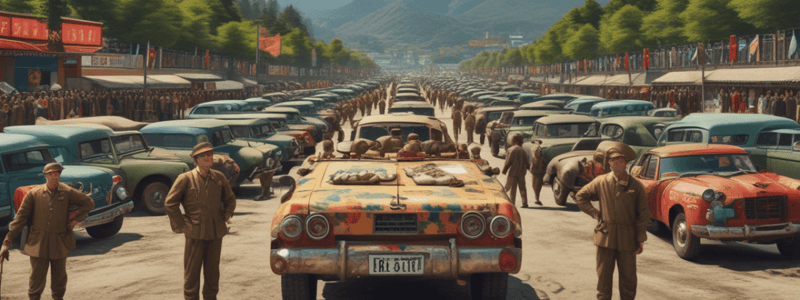Podcast
Questions and Answers
The Demilitarized Zone (DMZ) is a narrow region that separates North Korea and China.
The Demilitarized Zone (DMZ) is a narrow region that separates North Korea and China.
False (B)
South Korea's economy has flourished post-war, making it one of the leading economies globally.
South Korea's economy has flourished post-war, making it one of the leading economies globally.
True (A)
North Korea's economy has thrived due to significant foreign investments.
North Korea's economy has thrived due to significant foreign investments.
False (B)
The DMZ has prevented any military confrontations between North and South Korea.
The DMZ has prevented any military confrontations between North and South Korea.
The economic differences between North and South Korea can be attributed to political systems and external influences.
The economic differences between North and South Korea can be attributed to political systems and external influences.
Flashcards are hidden until you start studying
Study Notes
Introduction
North and South Korea are two distinct entities that share a tumultuous history. From the division caused by the Korean War to the ongoing tension between the countries, their relationship has been marked by conflict and disputes. Additionally, the economic disparities between the two nations have further widened the chasm separating them. This article provides a comprehensive overview of North and South Korea's history, focusing on the Korean War, the Demilitarized Zone (DMZ), and their economic differences.
The Korean War (1950-1953)
The Korean War was a major turning point in the relationship between North and South Korea. After World War II, Korea was divided into two zones along the 38th parallel, with the Soviet Union occupying the north and the United States occupying the south. However, political and ideological differences led to the formation of separate governments in each zone, culminating in the establishment of the Democratic People's Republic of Korea (DPRK) in the north and the Republic of Korea (ROK) in the south.
In June 1950, North Korean forces invaded South Korea, marking the beginning of the war. The conflict lasted for three years until an armistice was signed in July 1953. Despite an official state of war remaining between the two countries, the truce ended hostilities, establishing the DMZ as a buffer zone.
The Demilitarized Zone (DMZ)
The DMZ is a highly militarized region stretching approximately 2.5 miles wide that divides the Korean peninsula. It serves as a physical boundary between North and South Korea, preventing direct military confrontation. Over the years, there have been numerous incidents leading to heightened tension across the border, such as the assassination attempt on Park Chung-Hee, the bombing in Rangoon, and the destruction by time bomb of a South Korean airliner over the Thai-Burmese border. Despite these incidents, there have been significant efforts towards reconciliation, such as secret negotiations between North Korea and South Korea that led to the first significant contact between the countries in early 1972.
Economic Differences
The economic disparities between North and South Korea are stark. Since the war, South Korea has emerged as one of the world's leading economies, while North Korea remains one of the most impoverished nations on earth. This gap can be attributed to various factors, including political systems and external influences.
South Korea
Post-war, South Korea adopted a pro-West policy that helped it gradually build a robust economy. During the 1960s, President Park Chung-Hee launched the "Yushin Constitution," which focused on industrialization through state-led development policies. The country shifted to export-driven manufacturing industries like textiles, electronics, and steel production, making it one of the world's largest exporters today. South Korean companies have also invested heavily in other countries, expanding their global presence.
North Korea
On the other hand, North Korea's centrally planned economy has stagnated due to poor infrastructure, lack of investment, and international sanctions. The country has experienced famines, leading to widespread poverty and malnutrition. Despite its nuclear ambitions, North Korea faces challenges accessing markets and resources needed for economic growth.
Conclusion
The relationship between North and South Korea remains complex and fraught with tension. The legacy of the Korean War, the existence of the DMZ, and the stark economic disparities between the two nations have shaped their interactions over time. While there have been efforts towards reconciliation and engagement, the path towards unity continues to face numerous challenges.
Studying That Suits You
Use AI to generate personalized quizzes and flashcards to suit your learning preferences.




